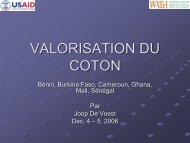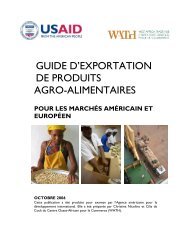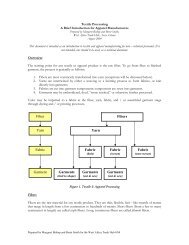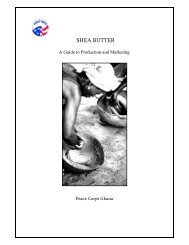A Value Chain Analysis of the Cashew Sector - AGOA Export Toolkit
A Value Chain Analysis of the Cashew Sector - AGOA Export Toolkit
A Value Chain Analysis of the Cashew Sector - AGOA Export Toolkit
You also want an ePaper? Increase the reach of your titles
YUMPU automatically turns print PDFs into web optimized ePapers that Google loves.
22 <strong>Cashew</strong> is grown as a smallholder crop in Ghana and <strong>the</strong> 2.3.1 Access to Land and Inputs for <strong>Cashew</strong> Farming<br />
commercial plantations sector is very small. It is estimated<br />
that about 88% <strong>of</strong> cashew farms are owned by smallholders,<br />
– and <strong>the</strong> Ecological Impact <strong>of</strong> <strong>Cashew</strong> Farming<br />
with farms ranging in size from a minimum 0.8 ha to 3.0 ha. Most <strong>of</strong> <strong>the</strong> agricultural land in Ghana is under communal ownership.<br />
Large plantations account for 12% <strong>of</strong> cashew farms and are Communal land is controlled by lineage- or clan-based land-owning<br />
sized between 4 ha to 40 ha (Osei-Akoto et al. 2005). According groups. It is allocated to individuals or households on an infrastruc-<br />
to estimates, <strong>the</strong>re were 60,000 ha under cashew cultivation in tural basis. In most parts <strong>of</strong> <strong>the</strong> country, particularly in <strong>the</strong> nor<strong>the</strong>rn<br />
2008, producing about 26,454 tonnes <strong>of</strong> raw cashew nuts per regions, women generally have diffi culties in accessing such land<br />
year (CDP, 2008). As a result <strong>of</strong> research, certain interventions except where it is owned by a group or where a male guarantor is<br />
have been implemented to address some <strong>of</strong> <strong>the</strong> production con- present. In principle, both men and women have equal rights <strong>of</strong><br />
straints experienced. Th ese interventions <strong>of</strong> improved planting access to land in many parts <strong>of</strong> Ghana, but in practice women are<br />
materials (seeds and grafts); rehabilitation <strong>of</strong> old unproductive <strong>of</strong>ten allocated smaller areas <strong>of</strong> poorer quality land that are far away<br />
farms through canopy substitution with scion materials from<br />
high yielding trees; selective thinning; pruning; and chemical<br />
control <strong>of</strong> weeds, pests and diseases.<br />
from villages or homesteads (IFAD, 1997).<br />
Most cashew trees start bearing fruit in <strong>the</strong>ir third or fourth<br />
year and are likely to reach <strong>the</strong>ir yield at maturity by <strong>the</strong> seventh<br />
year, that is, if conditions are favourable. Th e average<br />
yield <strong>of</strong> a mature tree ranges from 7 kg to 11 kg <strong>of</strong> nuts per<br />
year. Although <strong>the</strong> cashew tree can reach an age <strong>of</strong> 50 to 60<br />
years, most trees produce nuts for about only 15 to 20 years.<br />
Th e cashew tree grows with a minimum <strong>of</strong> attention and is<br />
easily cultivated. It is usually found up to an altitude <strong>of</strong> 1,000<br />
m above sea level, in regions where <strong>the</strong> annual rainfall is as<br />
low as 500 mm and as high as 3,750 mm. For maximum productivity,<br />
good soil and adequate moisture are essential. Optimal<br />
conditions include an annual rainfall <strong>of</strong> at least 889 mm<br />
and not more than 3,048 mm. Th e tree has an extensive root<br />
system, which helps it to tolerate a wide range <strong>of</strong> moisture<br />
levels and soil types, but commercial production is only advisable<br />
in well-drained, sandy loam or red soils (FAO, 2001).<br />
Currently, yields from improved seeds planted by farmers in<br />
Ghana vary from 350 kg/ha in some parts <strong>of</strong> <strong>the</strong> Interior<br />
Savanna to 650kg/ha in <strong>the</strong> Forest-Savanna Transition zone.<br />
However, through <strong>the</strong> planting <strong>of</strong> grafts from elite mo<strong>the</strong>r<br />
trees, <strong>the</strong> productivity <strong>of</strong> cashew plantations could potentially<br />
be raised from <strong>the</strong> present level to about 800-1,200 kg/ha.<br />
Elite mo<strong>the</strong>r trees produce at least eight kilos <strong>of</strong> nuts per tree<br />
annually, with an average nut weighing seven grams.<br />
Th e majority <strong>of</strong> cashew farmers experience severe diffi culties<br />
in obtaining necessary inputs. In most instances, <strong>the</strong> use <strong>of</strong><br />
agrochemicals for controlling pests and diseases has become<br />
inevitable. However, <strong>the</strong>se are only implemented on a limited<br />
basis because <strong>the</strong>y are ei<strong>the</strong>r unavailable (e.g. due to untimely<br />
distribution) or unaff ordable. Th e existing distribution system<br />
is generally weak, and characterised by a lack <strong>of</strong> funds, unreliable<br />
suppliers, as well as weak and poorly developed rural<br />
infrastructure.<br />
<strong>Cashew</strong> has been found to be a valuable tropical cash and food<br />
tree crop that can grow on even marginal lands. It has <strong>the</strong> ability<br />
to stabilise <strong>the</strong> soil in which it grows and is also a source<br />
<strong>of</strong> fuelwood. Th e additional tree cover provided by cashew<br />
plan tations helps to alleviate <strong>the</strong> pressure on local vegetation<br />
and increase soil fertility. Th is, in turn, helps mitigate <strong>the</strong><br />
eff ects <strong>of</strong> drought and desertifi cation. In addition, <strong>the</strong> use <strong>of</strong><br />
cashew shells to fi re boilers and ovens during processing reduces<br />
<strong>the</strong> need for cutting down trees for fuelwood, and hence reduces<br />
<strong>the</strong> pressure on surrounding forests.<br />
<strong>Cashew</strong> trees, as any o<strong>the</strong>r trees, serve as carbon sinks. Potential<br />
negative environmental impacts include loss <strong>of</strong> habitat and<br />
subsequent decrease in biodiversity, plus an increased possibility<br />
<strong>of</strong> crop loss due to higher susceptibility to pests and diseases.









